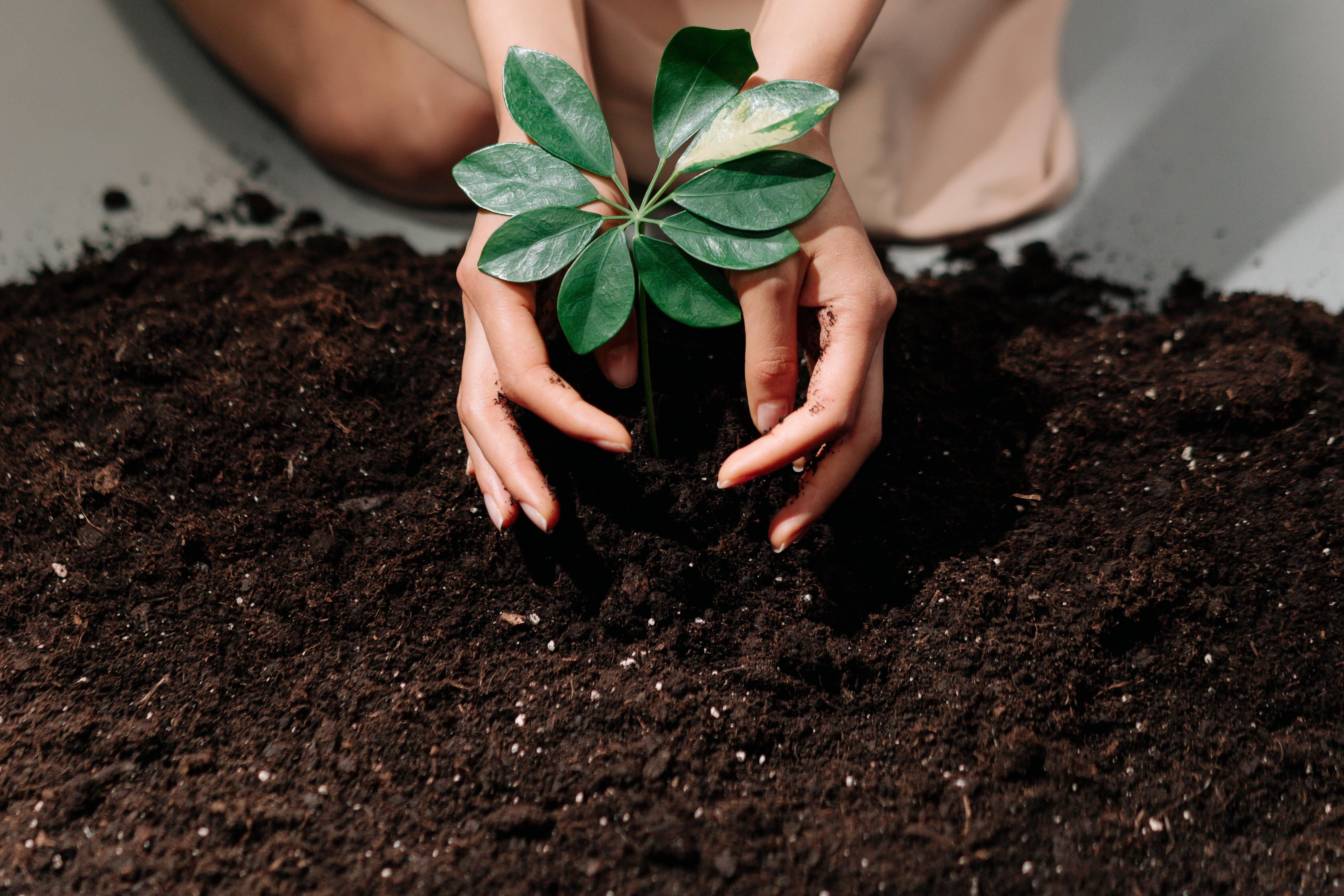
What Is Compost And Why Does It Matter?
Before you throw your next batch of food waste into the trash, consider starting to compost at home! Rather than having your food scraps end up in a landfill or incinerator, there are many benefits to recycling food and other organic waste into compost. This provides a wide range of environmental benefits such as reducing greenhouse gas emissions, improving soil for plant growth, recycling nutrients back to the earth, and more!

WHAT IS COMPOST?
Compost is decomposed organic material that enriches the soil and reduces the need for chemical fertilizers. Usually, it is used by farmers and gardeners to improve the quality of the soil. The main component of mature compost is Humus (pronounced (h)yo͞oməs/) which contains useful nutrients for healthy soil.
WHY IS COMPOST IMPORTANT?
Compost is important because it turns your kitchen and garden waste into valuable, healthy, and nutrient-rich soil. There are many significant reasons as to why it is important to compost such as:
- Reduces methane gas and makes us less dependent on landfills.
- Replaces chemical fertilizers with compost turned to soil.
- Improves compacted and contaminated soil. Thus, your farm or garden will be nourished with cost-effective compost
HOW DOES COMPOSTING WORK?
The process of compost works in 3 major stages:
- The first stage is the action of mesophilic microorganisms which takes place over a few days. The byproduct of this stage is heat which evolves by breaking down the biodegradable compounds.
- The second stage involves thermophilic microorganisms that are replaced by mesophilic microorganisms. They break down the organic compound into finer products. The more the compost decomposes, the higher the temperature continues to rise.
- The third stage is the longest in which thermophilic microorganisms keep on their work for several months. The temperature begins to decrease gradually and the final product is compost after this stage.
WHAT ARE THE TYPES OF COMPOSTING?
Depending on the quality and quantity of waste products, there are 5 types of composting:
- VERMICOMPOSTING
The type of decomposition that uses red worms is known as Vermicomposting. The red worms can eat yard trimmings, food scrap, and other organic compounds equal to half of their weight in just one day. Specific types of bins are easily found online. The red worms break down the material into compost called castings which can be used as potting soil.

2. AEROBIC COMPOSTING
This process of composting has an excess amount of air present. Air is introduced through a “tumble” style composter for Aerobic composting. If you are doing this process in a simple composting bin, the waste organic material should be turned maybe twice a week.

3. ANAEROBIC COMPOSTING
The process of composting without air is known as anaerobic composting. You don’t have to put any effort but time. The process is comparatively slow and due to the lack of oxygen, the compost material has an unpleasant smell.
4. WINDROW COMPOSTING
Windrow or Aerated composting works for a large volume of waste organic materials. These composting sites are managed by food supplying businesses or local governments. The organic matter is piled into long rows (windrows) and thus aerated properly. The height and weight of the pile should be between 4-8 feet and 14-16 feet.

5. DROP OFF AT YOUR LOCAL COMPOST-SITE
Composting is easy now because state regulations have allowed small composting sites at many community places such as Gardens, Churches, Universities, commercial properties...etc.
Small composting sites fill the gap between a larger commercial compost and smaller backyard compost.

You can even start a community compost site that can be accessed by 5-10 neighborhood residents. In case, if you are unable to find compost sites near you, there are likely compost pickup services. Numerous organizations are working to gather waste material for compost. Simply search if there are compost pickup services in your area.
HOW TO MAKE A COMPOST
Some parameters must be controlled before putting your waste into a pile to compost. First let's learn about the ratios needed:
THE BROWNS AND GREENS
When composting, you should be aware of the Browns and Greens. Browns are carbohydrate-rich materials which provide food to all the soil-dwelling organisms. While Greens are rich in protein or nitrogen. The composition of greens tends to produce heat and microorganisms as well. The ratio of these constituents should be 2:1 (brown to green).
- Browns- contain Twigs, Leaves, Paper, Corn Stalks, Straws, Cotton Fabric, etc.
- Greens- contain Vegetable and Fruit Scraps, Yard Trimmings, Grass Clippings, Eggshells, Animal Manure, etc.

MOISTURE CONTENT
Water should be present in the pile because it makes the nutrients acceptable for microbes (remember the organic chemistry from earlier?). The microorganisms need enough water to survive during the process of compost, which is why the high moisture content is necessary when dealing with compost
SURFACE AREA
Shredding, cutting, and breaking increase the surface area of the compost pile. Therefore, the pile would feed more microorganisms and the compost that is produced as a result would be a homogenous mixture.
TEMPERATURE
High temperature is good to decompose undesirable weed seeds and pathogenic organisms. Also, microorganisms produce their action at required temperatures which are 135° -160° Fahrenheit. This temperature can be reached by the action of microbial activity, if the temperature is not maintaining at least 135° Fahrenheit. Then, the compost would go towards the anaerobic condition.
Hence, to get sufficient microbial activity, you have to control the Browns and Green Ratio, moisture content, airflow, and Surface area. And thus, the temperature will automatically be reached at optimum conditions.
HOW NOT TO COMPOST?
If your composting process doesn't go smoothly, then there must be something that needs adjustment. Here are a few tips to help:
- The compost pile size is very important. It should not exceed 5’×5’×5’ or smaller than 3'x3'x3'.
- Don’t add grease, meat scraps, bones, or any dairy products that take more time in decomposition. They also cause odor around the composting pile and attract rodents.
- Dead plants and weed seeds are not decomposable until the temperature of your pile reaches up to 160 Fahrenheit. Hence, don’t add them to the composting material because they tend to mess up the compost ratio.
- Furthermore, let the water dry by putting the pile in direct sunlight. Eventually, the water consumption will be high, and more will be the reaction of microorganisms.
HOW LONG WILL IT TAKE A BAMBOO TOOTHBRUSH HANDLE TO DECOMPOSE?
The decomposition of bamboo toothbrushes depends on several conditions such as the quality of soil, temperature, atmosphere, and more. With these factors in mind, it may take anywhere from a few weeks to 10 years to decompose.
- Those who bury their toothbrushes can expect decomposition around 3 years
- A Home composter can take 4-6 months depending on the physical conditions.
- While an industrial composter can decompose the handle of your bamboo toothbrush in a few weeks.
- If you just throw your bamboo toothbrush handle in the garden, it will decompose in 5-10 years.

TIME TO DO SOME COMPOSTING!
While we can’t live in a perfect world where every material is composted rather than sent to landfills, we can at least strive to minimize the waste that we create in our daily lives. With the many different ways to compost, it is easy to add this simple routine to your everyday life to benefit your garden and the planet!




Leave a comment
This site is protected by hCaptcha and the hCaptcha Privacy Policy and Terms of Service apply.